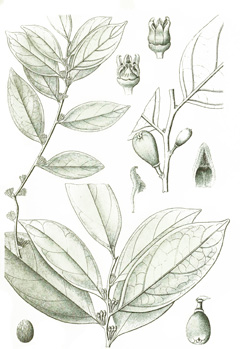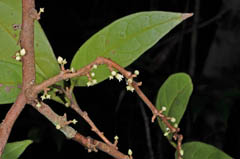 |
|
https://edibleplants.org/ |
 |
| Copyright © 2012 by P.B. Pelser & J.F. Barcelona |
Translate this page:
Summary
Anacolosa frutescens or commonly known as Galo is a tropical tree of up to 5 - 25 m tall that is found in the Philippines and in other South East Asian countries. Its leaves are pointed at both ends and in an alternate arrangement. The small flowers, which are in small clusters, are yellow in color. The fruit is a drupe, fleshy with a stone inside, and is yellow to orange in color. Both seed and fruit are edible - eaten raw or cooked. The nuts are thin-shelled and have good flavour and quality. Wood is hard and heavy but not durable and commonly used for house posts. The plant is grown from seed, air-layering, or cleft grafting. It has slow germination and early growth rate. It is also known as Galo nut, Kopi gunung, Tangki leuweung, Belian landak.
Physical Characteristics

 Anacolosa frutescens is an evergreen Tree growing to 15 m (49ft) by 15 m (49ft) at a medium rate.
Anacolosa frutescens is an evergreen Tree growing to 15 m (49ft) by 15 m (49ft) at a medium rate.
See above for USDA hardiness. It is hardy to UK zone 10.
Suitable for: light (sandy), medium (loamy) and heavy (clay) soils and prefers well-drained soil. Suitable pH: mildly acid, neutral and basic (mildly alkaline) soils. It can grow in full shade (deep woodland) or semi-shade (light woodland). It prefers moist soil.
UK Hardiness Map
US Hardiness Map
Synonyms
Anacolosa arborea Koord. & Valeton Anacolosa celebica Valeton ex Koord. Anacolosa heptandra Maingay
Plant Habitats
Edible Uses
Edible Parts: Fruit Seed
Edible Uses:
Edible portion: Nut, Fruit, Seeds. Seed - raw or cooked[ 301 ]. The thin-shelled nuts are of good flavour and quality, they are said to have the flavour of a mixture of sweet corn and chestnuts[ 301 , 324 ]. They contain 3.9 - 11.1% protein, 1.8 - 8% fat and 33.4 - 39'5% carbohydrate[ 301 ]. Fruit - raw or cooked[ 310 ]. Young fruits are delicious when boiled[ 301 ]. The pulp of mature fruits can be eaten cooked[ 301 ]. The yellow or orange fruit is a drupe, 15 - 25mm long, 12 - 20mm in diameter with a thin layer of pulp up to 6mm thick surrounding a single seed[ 324 ].
References More on Edible Uses
Medicinal Uses
Plants For A Future can not take any responsibility for any adverse effects from the use of plants. Always seek advice from a professional before using a plant medicinally.
None known
References More on Medicinal Uses
The Bookshop: Edible Plant Books
Our Latest books on Perennial Plants For Food Forests and Permaculture Gardens in paperback or digital formats.

Edible Tropical Plants
Food Forest Plants for Hotter Conditions: 250+ Plants For Tropical Food Forests & Permaculture Gardens.
More

Edible Temperate Plants
Plants for Your Food Forest: 500 Plants for Temperate Food Forests & Permaculture Gardens.
More

More Books
PFAF have eight books available in paperback and digital formats. Browse the shop for more information.
Shop Now
Other Uses
Wood
Other uses rating: Low (2/5). Other Uses: The pale, reddish-brown wood is hard and heavy, but not durable. It is used for house posts[ 324 , 451 ].
Special Uses
Food Forest
References More on Other Uses
Cultivation details
A plant of the moist tropical lowlands, usually growing at elevations up to 700 metres, exceptionally to 1,400 metres. It prefers a climate without a pronounced dry season[ 310 ]. Prefers a position with some shade[ 310 ]. The trees appear to be highly variable, with some high-yielding forms having been noted[ 324 ]. Seedlings grow slowly, taking about a year to reach grafting size[ 310 ]. Germination and early growth is slow. A mature fruit weighs 8-16 g. A kernel weighs 0.8-2.8 g.
References Carbon Farming Information and Carbon Sequestration Information
Temperature Converter
Type a value in the Celsius field to convert the value to Fahrenheit:
Fahrenheit:
The PFAF Bookshop
Plants For A Future have a number of books available in paperback and digital form. Book titles include Edible Plants, Edible Perennials, Edible Trees,Edible Shrubs, Woodland Gardening, and Temperate Food Forest Plants. Our new book is Food Forest Plants For Hotter Conditions (Tropical and Sub-Tropical).
Shop Now
Plant Propagation
Seed - germination takes more than 100 days[ 324 ]. Cleft-grafting onto seedlings 1 year old or more is highly successful[ 324 ]. Air layering. Takes about 4 months[ 310 ].
Other Names
If available other names are mentioned here
Galo Nut, Kopi gunung, Tangki leuweung, Belian landak.
Native Range
TROPICAL ASIA: India, Andaman and Nicobar Islands, Myanmar, Thailand (east), Indonesia, Kalimantan, Sulawesi (northeast), Jawa, Maluku, Sumatera, Malaysia, Philippines,
Weed Potential
Right plant wrong place. We are currently updating this section.
Please note that a plant may be invasive in one area but may not in your area so it's worth checking.
None Known
Conservation Status
IUCN Red List of Threatened Plants Status : This taxon has not yet been assessed.

Growth: S = slow M = medium F = fast. Soil: L = light (sandy) M = medium H = heavy (clay). pH: A = acid N = neutral B = basic (alkaline). Shade: F = full shade S = semi-shade N = no shade. Moisture: D = dry M = Moist We = wet Wa = water.
Now available:
Food Forest Plants for Mediterranean Conditions
350+ Perennial Plants For Mediterranean and Drier Food Forests and Permaculture Gardens.
[Paperback and eBook]
This is the third in Plants For A Future's series of plant guides for food forests tailored to
specific climate zones. Following volumes on temperate and tropical ecosystems, this book focuses
on species suited to Mediterranean conditions—regions with hot, dry summers and cool, wet winters,
often facing the added challenge of climate change.
Read More
Expert comment
Author
(Blume) Blume
Botanical References
1
Links / References
For a list of references used on this page please go here
A special thanks to Ken Fern for some of the information used on this page.
Readers comment
| Add a comment |
|
If you have important information about this plant that may help other users please add a comment or link below. Only comments or links that are felt to be directly relevant to a plant will be included. If you think a comment/link or information contained on this page is inaccurate or misleading we would welcome your feedback at [email protected]. If you have questions about a plant please use the Forum on this website as we do not have the resources to answer questions ourselves.
* Please note: the comments by website users are not necessarily those held by PFAF and may give misleading or inaccurate information.
To leave a comment please Register or login here All comments need to be approved so will not appear immediately.
|
Subject : Anacolosa frutescens
|
|
|
|